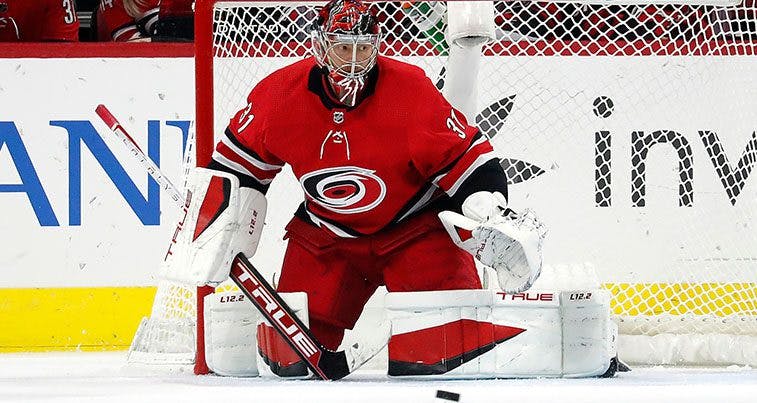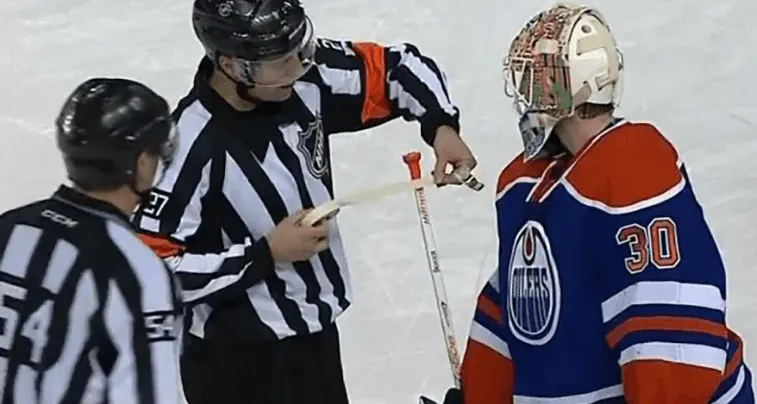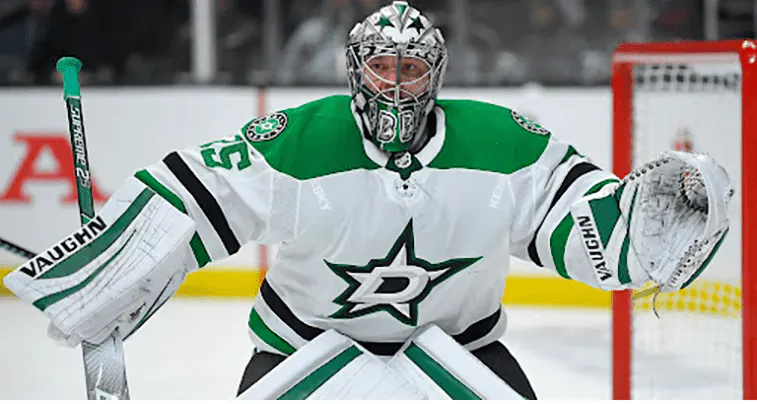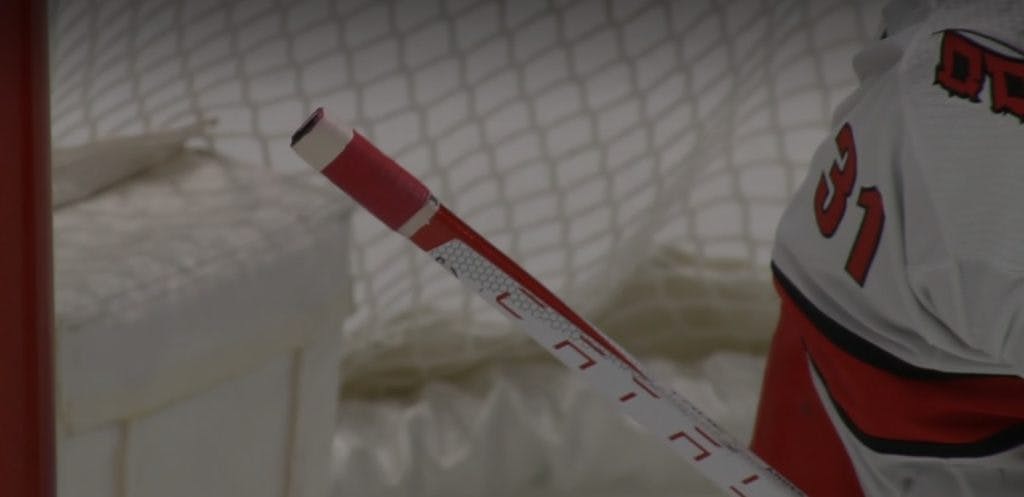McKenna: Making sense of the NHL’s obscure rules for knobs on goalie sticks

By: Mike Mckenna
You can’t use red tape on the end of your stick, Frederik Andersen.
For those wondering what was going on with the official taping Frederik Andersen's stick a few moments ago:
Per NHL Rule Book Section 10.2., goalies must have a knob of white tape or some other protective material approved by the League at the top of their goalie stick shaft. pic.twitter.com/I76K96tMy0
Why? Because of section 10.2 in the NHL’s Official Rules.
Goalkeeper’s Stick – In the case of a goalkeeper’s stick, there shall be a knob of white tape or other protective material approved by the League. This knob must not be less than one-half inch (1/2”) thick at the top of the shaft. Failure to comply with this provision of the rule will result in the goalkeeper’s stick being deemed unfit for play. The goalkeeper’s stick must be changed without the assessment of a minor penalty.
I’m 38 years old and the rule has been in place since before I was born. But why does it exist?
Pretty simple. Before video replay, the NHL used human beings as goal judges. They sat directly behind the net and worked in conjunction with the on-ice officials to determine whether a puck crossed the goal line.
A black knob on the end of a goaltender’s stick could easily be mistaken as a puck. And when the rule was written years ago, players had two tape colors to choose from. Black and white. By mandating goaltenders use white tape, the NHL was lessening the chance of blown calls by the goal judges.
In today’s world, endless colors of tape exist. Andersen was caught using red. And it wasn’t the first time. Back in October of 2017, when Andersen was a member of the Toronto Maple Leafs, he was caught using blue tape in a preseason game against the Winnipeg Jets and was forced to cover it with white.
Another incident occured in 2014, when the LA Kings faced off against the Edmonton Oilers. After the first round of the shootout, Kings head coach Darryl Sutter pulled the officials aside and pointed out the fluorescent orange knob on the stick of Oilers goaltender Ben Scrivens.
“I didn’t know the rule as written, I just knew the underlying reason was a black knob could be mistaken as a puck in a scramble,” Scrivens told Daily Faceoff. “So my understanding was, as long as it wasn’t black (or any dark color), it wouldn’t be mistaken for a puck so you’re within the rules.”

“I didn’t know what was going on when Sutter was talking to the refs, I just saw him pointing at me” Scrivens continued. “I laughed when it all happened because it was quite clearly an attempt at icing me, or getting in my head, which just told me I was in his head already. I stopped the next shooter and we won. I gave a mocking handclap to their bench as my team came down to celebrate.”
And then there’s Anton Khudobin. He’s been using colored tape for years and the Calgary Flames busted him during the 2019-20 Stanley Cup Playoffs. Yet if you look at Khudobin’s current sticks, the knob is green once again.

The rule doesn’t have any teeth. There’s no penalty for using a color other than white. I think that’s why some NHL goaltenders really don’t seem to care.
I’d actually be surprised if Andersen alters his taping habits moving forward. Changing the tape isn’t a minor detail – the red grip tape Andersen uses at the end of his stick has a much different feel than white cloth tape. It will take some experimenting on his part to find a comfortable solution.

What I find interesting is that Andersen’s stick was illegal for two reasons – tape color and an undersized knob. He’s supposed to have – at minimum – half an inch of tape at the top of his stick. Yet only the illegal color was addressed.
Unlike a player’s stick, the knob of a goalie stick is exposed during play. A half-inch of tape is required in an attempt to protect players from sharp corners. But for whatever reason in Andersen’s case, the officials let that portion of the rule slide.
Generally speaking, players know most of the rules. They’re made aware of any changes at the beginning of the season and adjust accordingly. But I’d be surprised if five percent of NHL players have ever cracked open a rule book. In their minds, they know what they need to know.
Until they don’t.
Occasionally someone on the opposing team will notify the on-ice officials of an illegal knob, and the result is what you saw in Thursday night’s game between the Anaheim Ducks and Carolina Hurricanes.
The referee comes over to the goaltender – in this case Frederik Andersen. He explains to the goaltender that his stick is illegal. A white strip of tape is placed at the top and play resumes.
Coaches will rarely call out an opposing goaltender’s illegal stick. It’s seen as petty and unnecessary. Greasy, if you will. But it is a rule.
I don’t believe veteran NHL referee Ian Walsh skated up to Andersen and told him to fix his stick on a whim. I would bet the farm that Anaheim Ducks head coach Dallas Eakins – or someone on his staff – tipped off Walsh.
Maybe it was Ducks assistant coach Newell Brown. His son, Adam, played goaltender in the WHL and then professionally for three seasons, mostly in the ECHL. Who knows – I’m guessing. But the timing was calculated. It was during a stoppage just after Hurricanes forward Martin Necas had been assessed a two-minute minor for delay of game.
The Ducks were headed to the power play. Calling out Andersen’s illegal knob bought them time. The delay allowed Anaheim’s top players to recover from a recent shift and have fresher legs for the start of the power play.
There’s also an element of psychological warfare. Forcing a goaltender to change their stick’s tape job mid-game can play into their mind – especially if they’re superstitious.
One night in Providence when I was playing for the Portland Pirates of the American Hockey League, I noticed Bruins goaltender Malcolm Subban was using black tape on the knob. When we came into the locker room after warmups, I told our coach Scott Allen – now head coach of the AHL’s Hershey Bears – about Subban’s illegal stick. We decided to keep it in our back pocket. Just in case.
In the third period we hit a critical juncture of the game and decided to play our card. Scott notified the referee, who skated down to Subban and forced him to put a strip of white tape on the end of his stick.
I can’t remember if we won or lost that night. But our prevailing thought was that maybe Subban was superstitious. Or overly particular about his gear. And maybe going to the bench for something so petty as the color of tape on his stick might throw him for a loop.
It was all mind games.
Section 10.2 is a truly archaic rule. There really isn’t a need for it any longer with video replay. And no one is going to confuse a red, orange, or green knob for a puck.
But rules are rules. And NHL teams will do anything to gain the upper hand.